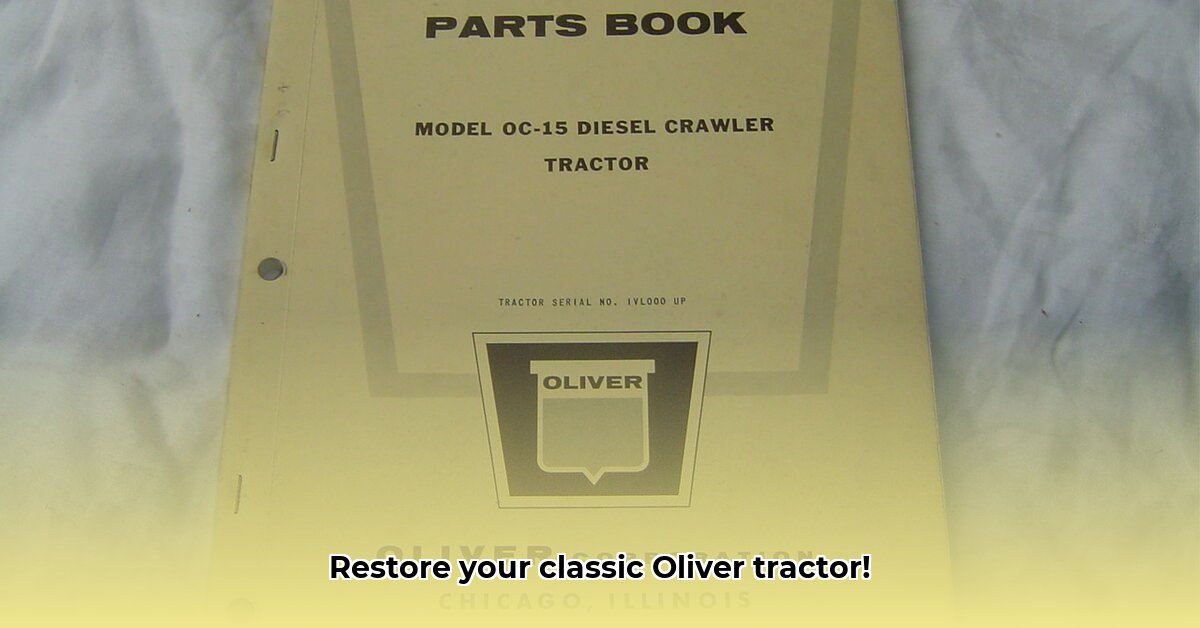
The iconic roar of a vintage Oliver tractor evokes a bygone era of American farming. These robust machines, built to withstand the rigors of agricultural life, are now cherished by collectors and enthusiasts. Maintaining these mechanical marvels requires a deep understanding of their inner workings, and the 1958 Oliver tractor parts manual is your invaluable guide. This comprehensive guide will walk you through locating, understanding, and utilizing this essential resource for restoration and ongoing maintenance. For visual inspiration, check out these Oliver tractor pictures.
Locating Your 1958 Oliver Parts Manual: A Treasure Hunt
Before you can begin restoring your 1958 Oliver, you need the parts manual—your roadmap to success. Where can you find this crucial document? Let's explore your options:
Online Marketplaces: Websites like eBay and specialized vintage farm equipment sites are excellent starting points. Search for "1958 Oliver tractor parts manual PDF" or variations thereof, specifying your tractor's model number for optimal results. Remember to verify the manual's compatibility with your specific model.
Collector Clubs: Joining an Oliver tractor collectors' club offers unparalleled access to a network of knowledgeable enthusiasts. These communities often share resources, and you might find someone with a digital copy or willing to lend a physical manual. The power of community is immense in this field. Do a quick online search for local or national clubs.
Libraries and Archives: Local libraries, especially those with strong agricultural collections, or agricultural archives might hold a copy of the manual. Don't hesitate to contact these institutions; their collections are often extensive and underutilized.
Online Forums: Dedicated online forums like Yesterday's Tractors (a great example) provide a platform for sharing knowledge and resources. You may find someone willing to share a scanned copy or point you toward additional resources.
Decoding the Manual: Understanding the Tractor's Language
The 1958 Oliver parts manual isn't just a collection of pictures; it's a meticulously organized system. Mastering its structure is key to successful restoration. Typical features include:
Sectioned Organization: The manual divides the tractor into systems (engine, transmission, hydraulics, etc.), making it easy to locate specific components.
Detailed Diagrams: Exploded diagrams show each component's location within a sub-assembly. These diagrams are fundamental to understanding assembly and disassembly sequences.
Part Numbering System: Each part has a unique number, enabling easy identification and ordering of replacements. This is essential in ensuring the correct part is obtained.
Specifications and Tolerances: Pay close attention to details like torque settings, clearances, and other specifications. These values are crucial for proper assembly and optimal performance. Incorrect torque can damage parts.
Using the Manual for Repairs: A Step-by-Step Process
The manual isn't just for major overhauls; it's your guide for routine maintenance and troubleshooting. Let's illustrate with a common task: replacing a fuel filter.
Example: Fuel Filter Replacement
- Consult the Manual: Identify the correct fuel filter part number for your specific Oliver model.
- Locate the Filter: Use the diagram to precisely locate the filter's position.
- Drain Fuel: Carefully drain any residual fuel before removing the old filter.
- Remove Old Filter: Unscrew and remove the old filter, taking note of the orientation for reassembly (if applicable).
- Install New Filter: Install the new filter, ensuring a tight seal and proper orientation.
- Check for Leaks: Inspect all connections for leaks before starting the engine.
Troubleshooting with Your Manual: Solving Mechanical Mysteries
Even with meticulous care, problems can arise. The 1958 Oliver parts manual's troubleshooting sections become invaluable during these situations. Let's consider a common problem:
Example: Tractor Won't Start
Your manual might guide you through a systematic check of the battery, starter motor, ignition system, and fuel system. Such a structured approach minimizes guesswork and aids in a quick resolution. Following the manual's instructions step by step is essential.
Have you considered checking the battery connections and cables? (A faulty connection frequently causes issues)
Sourcing Parts: Locating Those Missing Pieces
Finding parts for a vintage tractor can be a challenge. Here are your best strategies:
Online Retailers: Numerous online retailers specialize in vintage tractor parts. These sources can provide both new and remanufactured parts.
Salvage Yards: Local salvage yards or scrapyards might hold unexpected treasures. Careful inspection is key.
Collector Networks: Leverage your collector networks and online forums—fellow enthusiasts often know obscure sources or have parts available for sale or trade.
Reproduction Parts: For truly impossible-to-find parts, consider buying reproduction parts. Quality varies so research your suppliers carefully.
Safety First: Protecting Yourself and Your Investment
Safety is paramount when working on any machinery. Always:
- Wear Appropriate Safety Gear: Gloves, eye protection, and sturdy shoes are essential.
- Work in a Well-Ventilated Area: Ensure adequate ventilation to avoid harmful fumes.
- Disconnect the Battery: Always disconnect the battery before working on electrical components.
- Never Work Alone: Always have a helper present for assistance and safety.
By carefully following the guidance of your 1958 Oliver tractor parts manual and prioritizing safety, you can successfully restore and maintain this piece of agricultural history. The payoff of owning and preserving this classic machine is immense.